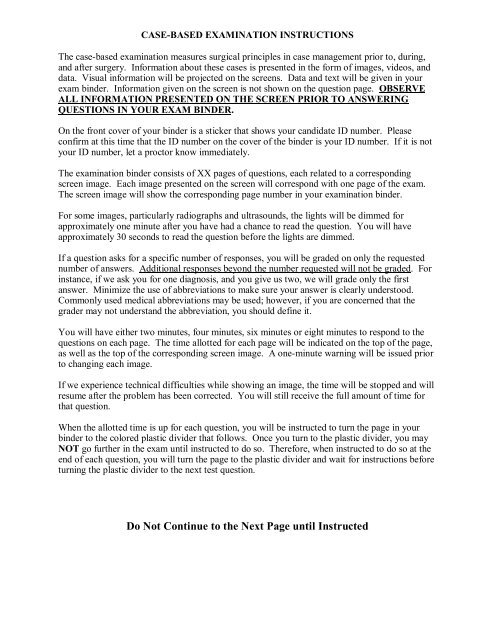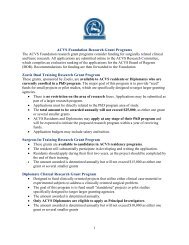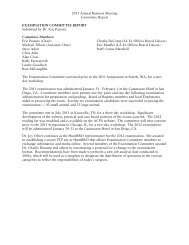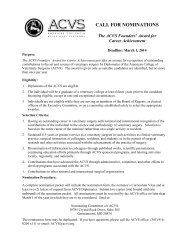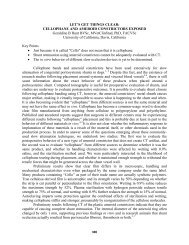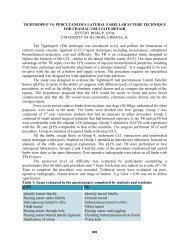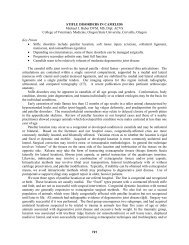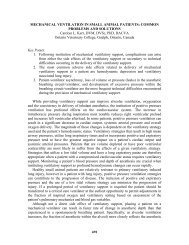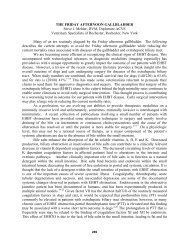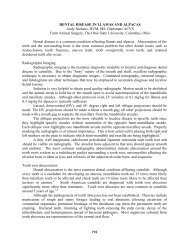Small Animal Orthopedic Case Based Examination Question Sheet
Small Animal Orthopedic Case Based Examination Question Sheet
Small Animal Orthopedic Case Based Examination Question Sheet
You also want an ePaper? Increase the reach of your titles
YUMPU automatically turns print PDFs into web optimized ePapers that Google loves.
CASE-BASED EXAMINATION INSTRUCTIONS<br />
The case-based examination measures surgical principles in case management prior to, during,<br />
and after surgery. Information about these cases is presented in the form of images, videos, and<br />
data. Visual information will be projected on the screens. Data and text will be given in your<br />
exam binder. Information given on the screen is not shown on the question page. OBSERVE<br />
ALL INFORMATION PRESENTED ON THE SCREEN PRIOR TO ANSWERING<br />
QUESTIONS IN YOUR EXAM BINDER.<br />
On the front cover of your binder is a sticker that shows your candidate ID number. Please<br />
confirm at this time that the ID number on the cover of the binder is your ID number. If it is not<br />
your ID number, let a proctor know immediately.<br />
The examination binder consists of XX pages of questions, each related to a corresponding<br />
screen image. Each image presented on the screen will correspond with one page of the exam.<br />
The screen image will show the corresponding page number in your examination binder.<br />
For some images, particularly radiographs and ultrasounds, the lights will be dimmed for<br />
approximately one minute after you have had a chance to read the question. You will have<br />
approximately 30 seconds to read the question before the lights are dimmed.<br />
If a question asks for a specific number of responses, you will be graded on only the requested<br />
number of answers. Additional responses beyond the number requested will not be graded. For<br />
instance, if we ask you for one diagnosis, and you give us two, we will grade only the first<br />
answer. Minimize the use of abbreviations to make sure your answer is clearly understood.<br />
Commonly used medical abbreviations may be used; however, if you are concerned that the<br />
grader may not understand the abbreviation, you should define it.<br />
You will have either two minutes, four minutes, six minutes or eight minutes to respond to the<br />
questions on each page. The time allotted for each page will be indicated on the top of the page,<br />
as well as the top of the corresponding screen image. A one-minute warning will be issued prior<br />
to changing each image.<br />
If we experience technical difficulties while showing an image, the time will be stopped and will<br />
resume after the problem has been corrected. You will still receive the full amount of time for<br />
that question.<br />
When the allotted time is up for each question, you will be instructed to turn the page in your<br />
binder to the colored plastic divider that follows. Once you turn to the plastic divider, you may<br />
NOT go further in the exam until instructed to do so. Therefore, when instructed to do so at the<br />
end of each question, you will turn the page to the plastic divider and wait for instructions before<br />
turning the plastic divider to the next test question.<br />
Do Not Continue to the Next Page until Instructed
UNDER NO CIRCUMSTANCES ARE YOU ALLOWED TO MOVE FORWARD IN<br />
THE EXAMINATION UNTIL INSTRUCTED. FURTHERMORE, YOU MAY NOT<br />
RETURN TO A PREVIOUS PAGE OF QUESTIONS AT ANY TIME DURING THE<br />
EXAM. FAILURE TO FOLLOW THESE INSTRUCTIONS WILL RESULT IN<br />
DISQUALIFICATION FROM THE EXAM.<br />
Scrap paper has been supplied for you to take notes during the exam. You are encouraged to use<br />
the scrap paper throughout the exam. You can refer to the notes on your scrap paper for the<br />
entire duration of the exam. Your scrap paper will not be scored.<br />
Raise your hand if you need additional pencils, have a question, or if you need to leave the room<br />
for any reason. We highly recommend that you do not leave the examination for any reason<br />
since questions cannot be revisited once they have been shown.<br />
Are there any questions before we begin the exam?
<strong>Small</strong> <strong>Animal</strong> <strong>Case</strong>-<strong>Based</strong> <strong>Examination</strong><br />
ORTHOPEDIC SECTION<br />
PAGE 1 (4 minutes)<br />
A 4.5 month old male Labrador retriever is presented with a 2-month history of a gradually<br />
worsening weight-bearing lameness of the left forelimb. The radiographs are from the affected<br />
left leg and the normal right leg.<br />
1. List six radiographic abnormalities present on the left leg.<br />
A.<br />
B.<br />
C.<br />
D.<br />
E.<br />
F.<br />
2. What is the specific diagnosis?
PAGE 2 (2 minutes)<br />
1. What are four etiologies of this type of deformity in dogs?<br />
A.<br />
B.<br />
C.<br />
D. ____________________________________
PAGE 3 (4 minutes)<br />
These are radiographs of the affected leg. The angle labeled A measured 43 degrees. The angle<br />
labeled B measured 65 degrees.<br />
1. Describe one effective surgical treatment plan. Be specific.<br />
2. If this were a different 4 month old Labrador with a mild deformity, (angle labeled A had<br />
measured 19 degrees and the angle labeled B measured 12 degrees), what would your<br />
treatment plan be?
PAGE 4 (4 minutes)<br />
This is a “close up” image of the affected physis in this dog.<br />
1. What is the most likely Salter-Harris classification for this injury?<br />
2. What are four histologic zones of the normal physis?<br />
A.<br />
B.<br />
C.<br />
D.<br />
3. What form of ossification would normally take place at this physis?<br />
4. In this particular case, which two zones were most likely affected to cause this deformity?<br />
A.<br />
B.<br />
5. If the cause of this deformity had been retained cartilaginous cores, which zone of the physis<br />
would have been most seriously affected?
PAGE 5 (4 minutes)<br />
This image is a “close up” from the osteotomy of the radius, two months after beginning<br />
treatment.<br />
1. What is the name of the process seen at this osteotomy site?<br />
2. What is the zone labeled with the yellow arrow?<br />
3. What is the form of ossification that develops in the zone labeled with the yellow arrow?<br />
4. What are four steps in the ossification process at the osteotomy site in the order of<br />
occurrence?<br />
A.<br />
B.<br />
C.<br />
D.
PAGE 6 (4 minutes)<br />
This device is similar to the one used on this dog.<br />
1. What is the name of this device?<br />
2. Axial micromotion is beneficial to generation and healing of bone. How much (mm) axial<br />
micromotion is desirable for this construct?<br />
3. List five factors that affect the stiffness of the fixator construct at the osteotomy site.<br />
A.<br />
B.<br />
C.<br />
D.<br />
E.<br />
4. Name two linear external fixator systems that could accomplish distraction osteogenesis.<br />
A. _____________________________<br />
B. _____________________________


